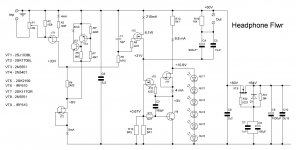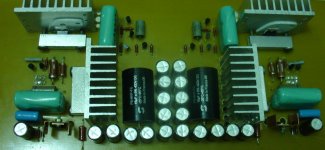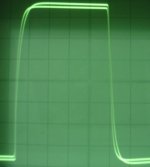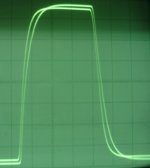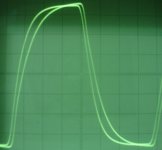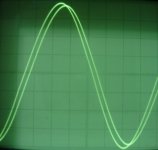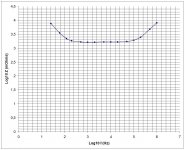This is a modified Follower-99 based schematics, with the front amplification stage (Ku=11) and output impedance 1,5 Ohms. Almost perfect reproduce 500kHz square wave signal, time delay between input and output sine signal is 34ns (0,034us).
Output capacitor is made of 9pcsx100uFx63V Elna Silmic II + 15uFx400V Solen Polypropylene cap.
Separate shunt power supply is used for the front stage.
Signal pictures (input and output signals) are 200kHz, 500kHz , 1MHz square wave, and 1MHz sine wave.
Output capacitor is made of 9pcsx100uFx63V Elna Silmic II + 15uFx400V Solen Polypropylene cap.
Separate shunt power supply is used for the front stage.
Signal pictures (input and output signals) are 200kHz, 500kHz , 1MHz square wave, and 1MHz sine wave.
Attachments
Last edited:
Very impressive. Di You try it like line preamp also? How it sound?
I have not make listening still, plan to do it with my Sennheiser HD595 headphones, although this model is not probably a high-end one.
It should also good serve as a preamp, with more than 20dB voltage amplification and 50V peak-to-peak undistorted voltage swing, with 1,5Ohms output impedance it is capable to drive any "difficult" power amp or output stage.
More definitely, after testing of this version, I plan to extend it to an integrated class A amplifier, by removing output capacitors and adding an output stage, based on 2SK1529 matched transistors, similar to the present second stage.
Nice little radio amp you have here
By the way, from a short look at your schematic it appears the ground-symbols are not where they belong to.
It's not eco-friendly to short +60V to ground
Hannes
All is fine with ground simbols here.
More definitely, after testing of this version, I plan to extend it to an integrated class A amplifier, by removing output capacitors and adding an output stage, based on 2SK1529 matched transistors, similar to the present second stage.
So it should be an integrated SE amplifier. Im very interested how it will sound. Im using a tube preamp to drive My Follower99, (little tired of that sound).
So, according You, this preamp should work well as a gain stage for PF99 also. I would like to build this preamp and see how it sound. Do You have any plans for modifications or further improvements?
Look at input at the left side; upper input point is connected to ground, whereas same connection goes to +60V at the right side.
Lower input should be grounded; same as the source of VT2.
Hannes
Yes I can see it, its a ground of input signal, output and chassie. Its nothing wrong to use that kind of aproach.
schematic.info : Power Follower 99
Yes amp it is possible deign a workable amp with negative cathodes and grounded "B+" (very strange approach however).
But ground is 0V and should be marked 0V not +60V since its misleading. Above schematics should be corrected with appropriate voltages accordingly.
Why are you avoiding feedback?
As per my listening experience, amps based on NFB designs, all other parameters being perfect, they colorate sound a little bit, in a kind of slight "sandy" color, if the amp is transparent enough (for instance, I consider Yamaha B-2x as one of the best NFB amps, it is very transparent, but slight "sandy" taste is there). If an amp is not transparent, like majority of Hi-Fi examples, then it does not matter with or without NFB an amp is. My principle, take the best parts for a given application, and achieve good parameters without NFB.
Last edited:
All recording was done with NFB recording equipment. Do you do your own non NFB recording?
All or most modern mass production records? What about NOS LPs? What about modern TACET tube recorded LPs?
All recording was done with NFB recording equipment. Do you do your own non NFB recording?
I would not be sure that ALL recordings are done similarly, but I agree that major part of them are done for car audio.
For home listening, I look for XRCD, K2U and other enhanced fidelity recordings, some normal ones from respectable manufacturers are also very good. But I woud not like to continue such arguments in this thread. I find no reason to discuss how to make a chip based amp for not very good recordings.
I just have measured the impedance modulus curve, plotted in double logariphmic scale.
900uF of output cap is actually not enough (gives 7,6Ohms at 25Hz), for 32Ohms headphones I would add another 900uF. Impedance value at the flat region is nearly 1660mOhms. Above 100kHz impedance goes up due to parasitic inductances.
900uF of output cap is actually not enough (gives 7,6Ohms at 25Hz), for 32Ohms headphones I would add another 900uF. Impedance value at the flat region is nearly 1660mOhms. Above 100kHz impedance goes up due to parasitic inductances.
Attachments
I am not sure whether TACET tube gear has NFB or not either but all always never are so powerful statement that make sense using them with some care imho. Actually global NFB might sounds very nice in some amplifiers and might not be so necessary in other if top notch fidelity component are in use.But I would not like to continue such arguments in this thread.
Have you think about using OT instead of output capacitors? imho capacitors are great for low power signal but once we are talking about 1W or more OT might work better.
Have you think about using OT instead of output capacitors? imho capacitors are great for low power signal but once we are talking about 1W or more OT might work better.
Output transformer can be done very good, but cluster-like solutions for output capacitor with big high quality shunts also lead to perfect result. For experimenting with various output cap solutions, I have bought expensive and high quality SE 300B based tube amp, for having top reference point. Very definite conclusion I made is, no output signal current through PS rails give so big and firm positive result, that output cap danger really disappear, in comparison tests, including best SS and tube disigns.
Interesting observations, Vladimir. On my 28W SE mosfet/tube hybrid I used 1800uF, which was fine with speakers to 4R. I did NOT use Ciuffoli's method; I am confident it would sound better because ripple is not coupled to the signal path.
However, I do have some doubts about the mosfet series regulator. In my experience cap multipliers add the transfer function of the active device to the output, but in Ciuffoli's case since ripple is no longer relevant at that point because of the blocking effect of the CCS this issue may not be important. Nevertheless, a comparison with CLC would be interesting, typically 22,000uF/15mH/22,000uF.
Hugh
However, I do have some doubts about the mosfet series regulator. In my experience cap multipliers add the transfer function of the active device to the output, but in Ciuffoli's case since ripple is no longer relevant at that point because of the blocking effect of the CCS this issue may not be important. Nevertheless, a comparison with CLC would be interesting, typically 22,000uF/15mH/22,000uF.
Hugh
However, I do have some doubts about the mosfet series regulator. In my experience cap multipliers add the transfer function of the active device to the output, but in Ciuffoli's case since ripple is no longer relevant at that point because of the blocking effect of the CCS this issue may not be important. Nevertheless, a comparison with CLC would be interesting, typically 22,000uF/15mH/22,000uF. Hugh
Yes, Hugh, one always should compare variants. Since I tend to have PS ripples+HF constituents (mainly HF noise-like distortions of the rail voltage) under load less than 0,1mV peak-to-peak, cap multiplier gives an economic solution. Also, to me, active device in series with active schematics makes less "sound losses" than e-cap in series. Anyway, one should be careful with PS.
I have added all kind of connectors to the prototype, connected temporary power supply, and now can report first listening impressions.
I tested it as a preamp in the system with the modified follower HF transistors
I listened via Sennheiser HD595 headphones
I listened it as a small power amp (0,1W out power) with Castle Acoustics Pembroke speakers (surprisingly sound is quite loud and allows to get main impressions)
I can say, sounds very clear, very direct, nothing from "sandy" flavour, excellent 3D scene, sounds similar to that from the modified follower.
Gives the best sound that I heard via headphones.
As a preamp, I still have to compare with my high-voltage SIT preamp.
I tested it as a preamp in the system with the modified follower HF transistors
I listened via Sennheiser HD595 headphones
I listened it as a small power amp (0,1W out power) with Castle Acoustics Pembroke speakers (surprisingly sound is quite loud and allows to get main impressions)
I can say, sounds very clear, very direct, nothing from "sandy" flavour, excellent 3D scene, sounds similar to that from the modified follower.
Gives the best sound that I heard via headphones.
As a preamp, I still have to compare with my high-voltage SIT preamp.
Last edited:
- Status
- This old topic is closed. If you want to reopen this topic, contact a moderator using the "Report Post" button.
- Home
- Amplifiers
- Solid State
- No NFB Headphone/Pre Amp
